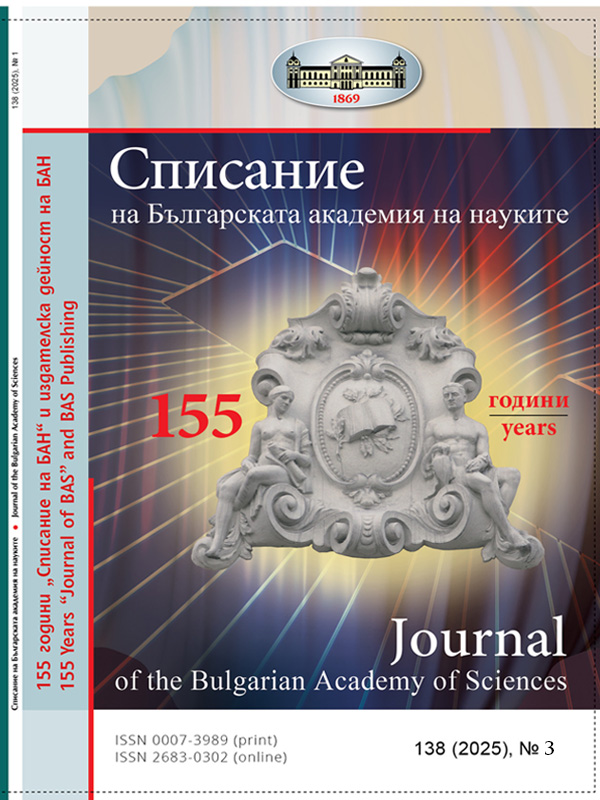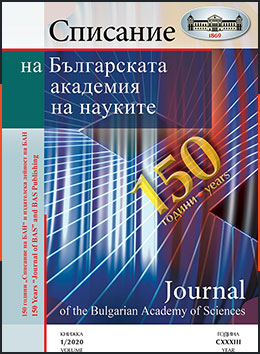Journal View
Journal of the Bulgarian Academy of Sciences
- Year: 2025
- Number: 3
- Language: Български, English
- Download Issue

- Official Celebration of the Day of the Holy Brothers Cyril and Methodius, of the Bulgarian Alphabet, Education and Culture and of the Slavonic Literature
- Congratulatory Address by the President of BAS Corresponding Member Evelina Slavcheva
- Academic speech of the Bulgarian Patriarch Daniil
- Awards for young scientists “Prof. Marin Drinov” and the youngest scientists “Ivan Evstratiev Geshov”, for 2024
-
Genomic Approaches for Studying and Diagnosing Hereditary and Oncological Diseases
Author(s): Desislava VladimirovaAbstract: In recent decades, genomics has made significant advances, revolutionizing the diagnosis and treatment of hereditary and malignant diseases. The development of technologies such as DNA sequencing has not only enabled more precise identification of pathogenic mutations but has also expanded the possibilities for personalized medicine. Genetic testing now plays a critical role in the early diagnosis of hereditary diseases like cystic fibrosis, Marfan syndrome, and hemophilia, allowing for timely and targeted therapeutic interventions. In oncology, genomic profiling of tumors provides valuable information about specific molecular alterations, aiding in the selection of targeted therapies and predicting therapeutic responses. This significantly improves treatment effectiveness and minimizes side effects associated with traditional therapeutic approaches. However, despite these advancements, several challenges remain that limit the widespread implementation of genomics in clinical practice. These include the high costs of genetic analyses, unequal access to innovative technologies, and ethical concerns related to the storage and use of genetic data. Nevertheless, the future development of genomics and personalized medicine promises increasingly accessible and effective methods for the diagnosis, prevention, and treatment of various diseases. Ongoing research in this field will deepen our understanding of the genetic mechanisms underlying numerous pathological conditions. This will lead to the development of new therapeutic strategies and reinforce genomics’ role as a key factor in the future of medicine.
-
Santorini – Beauty under Threat (Seismogeological Overview)
Author(s): Ivan ZagorchevAbstract: Various seismogeological aspects of the SantoriniAmorgos February Earthquake Sequence are discussed. The Santorini-Amorgos Rift and its relations with the South-Cycladian Volcanic Arc give the unique opportunity to study the mutual control of tectonism and the igneous and metamorphic processes in subduction and island arc environments. The assessment of the zeodynamic hazards (seismicity, volcanism, tsunamis, landslides and rockfalls) and the social response are extremely important for the Aegean and continue to be in the focus of scientific and public interest.
-
The Blind and Blinding Mask
Author(s): Ivan MarazovKeywords: blinding, petrification, death, funerary function, Medusa, mound, tombAbstract: The function of the gold masks found in the Balkans and in Thrace is funerary – they have to give a face to the “faceless” dead, to include them into the generation of the “golden people”. Death is silent and invisible/black. That is why there is no visual communication with the other world, and Medusa’s view is dangerous – it petrifies, e.g. blinds. Petrifying is semantically equivalent to the blindness and deafness caused by the visual contact with the character from the world beyond/mask. The stoning corresponds to the ritual practice of Lapidatio. The ban on seeing sacred objects provides blindness as punishment. Deprivation of vision is the same as castration, a punishment for excessive sexual practices. The funerary mound is seen but hiding. Monumental and silent, it challenges stories about the dead ruler: awakens epic legends related to his glory, and thus updates the memory of his exploits, keeps his “name” for the next generations. It serves as a mute visual marker but is mythologically processed in acoustic code. By entering the architectural complex Golyama Kosmatka tomb, the ruler is first “petrified” from the sight of Medusa, presented on the left door, he is blinded – the door is entirely painted in black, and then reborn, e.g. “sees the light” in the image of Helios – Apollo on the right, red door.
-
How Was It Reached and What Was (Not) Achieved by the Changes in the Regulations for the Application of the Academic Staff Development Act in the Republic of Bulgaria in Professional Field 4.4. Earth Sciences?
Author(s): Ivan Drenovski, Marin RusevKeywords: act of academic staff development, implementing rules, discriminatory provisions, discrepanciesAbstract: This article analyses the newly adopted amendments to the Regulations for the application of the Academic Staff Development Act (RAASDA) in Professional Field 4.4. It traces the chronology of events leading to these changes, discusses their justification and sustainability, and relates them to the impact assessment of the adoption of the new regulations. It concludes by noting that the amendments do not overcome inconsistencies and inequities in the treatment of representatives of different scientific areas and professional fields. Proposals are made for further comprehensive and principal changes to the RAASDA.
-
The Eternal Clash – Minister vs. Rector
Author(s): Lisbet Lyubenova
- Presentation of the Book “Dostoevsky. Questions of a Mathematician
-
Entering the Spiritual Universe of Dostoevsky
Author(s): Ivan Granitsky
- A Speech by Academician Petar Popivanov
-
Theory of Parallel Lines and Dostoevsky
Author(s): Ivan Popchev
- In the Management Board of the Bulgarian Academy of Sciences: Newly Elected Directors of Institutes
- In the Management Board of the Bulgarian Academy of Sciences: Re-elected Directors of Institutes
- In the Management Board of the Bulgarian Academy of Sciences: New Composition of the Publishing Council
- Prof. Ivan Shopov Award for an Outstanding Young Scientist in the Field of Polymers
- Young Scientist from the Bulgarian Academy of Sciences Has Been Elected as a Representative in the Global Youth Academy
-
The Fiery Journalism of Geo Milev (100 Years since the Poet‘s Death)
Author(s): Ivan Granitsky
-
Sisyphus, or the Repetition of Perfection
Author(s): Vladimir Zarev
-
Valeri Petrov and the Literature of the Late 1940s and 1950s
Author(s): Panko Anchev
Journal of BAS
ISSN 0007-3989 (print)
ISSN 2683-0302 (on line)
150 Years
"Journal of the BAS"

Sections in the Issue
In the issue you can read articles from the following sections.
